BTEC HND Business and Business Environment Report: HSBC Bank
VerifiedAdded on 2020/06/06
|9
|2117
|352
Report
AI Summary
This report provides a comprehensive analysis of HSBC, a leading international bank, focusing on its business environment. It begins by exploring the different types, sizes, and scopes of organizations, applying these concepts to HSBC's structure. The report then delves into the interrelationship of various functions within an organization, such as human resources, finance, and marketing, highlighting their importance and how they contribute to HSBC's success. Furthermore, the analysis examines the positive and negative impacts of the macro environment on HSBC's operations, considering factors like economic conditions and market trends. Finally, the report assesses HSBC's internal strengths and weaknesses, linking them to external macro factors, to provide a holistic understanding of the bank's position and performance within the business landscape. The report includes a conclusion summarizing the key findings and provides a detailed list of references.
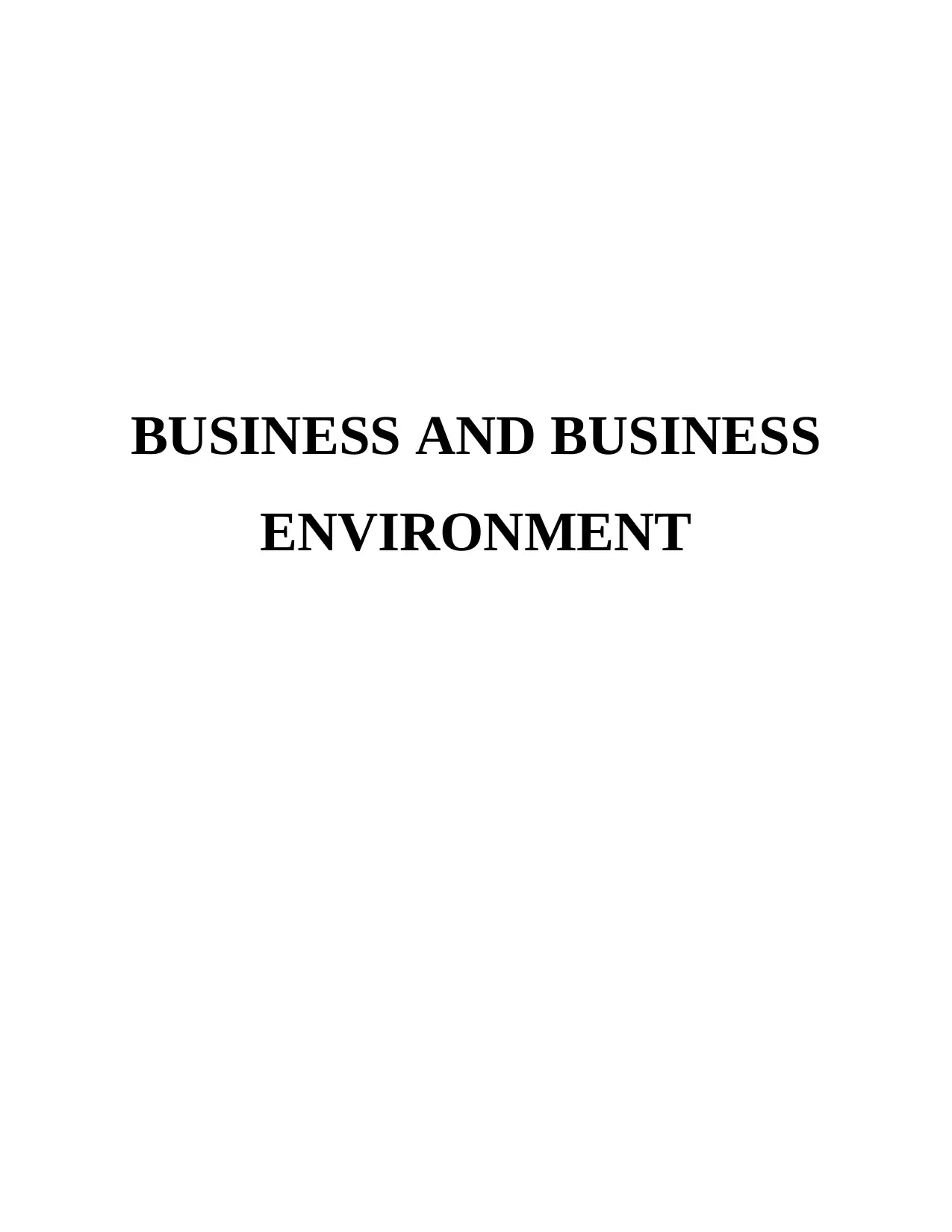
BUSINESS AND BUSINESS
ENVIRONMENT
ENVIRONMENT
Paraphrase This Document
Need a fresh take? Get an instant paraphrase of this document with our AI Paraphraser
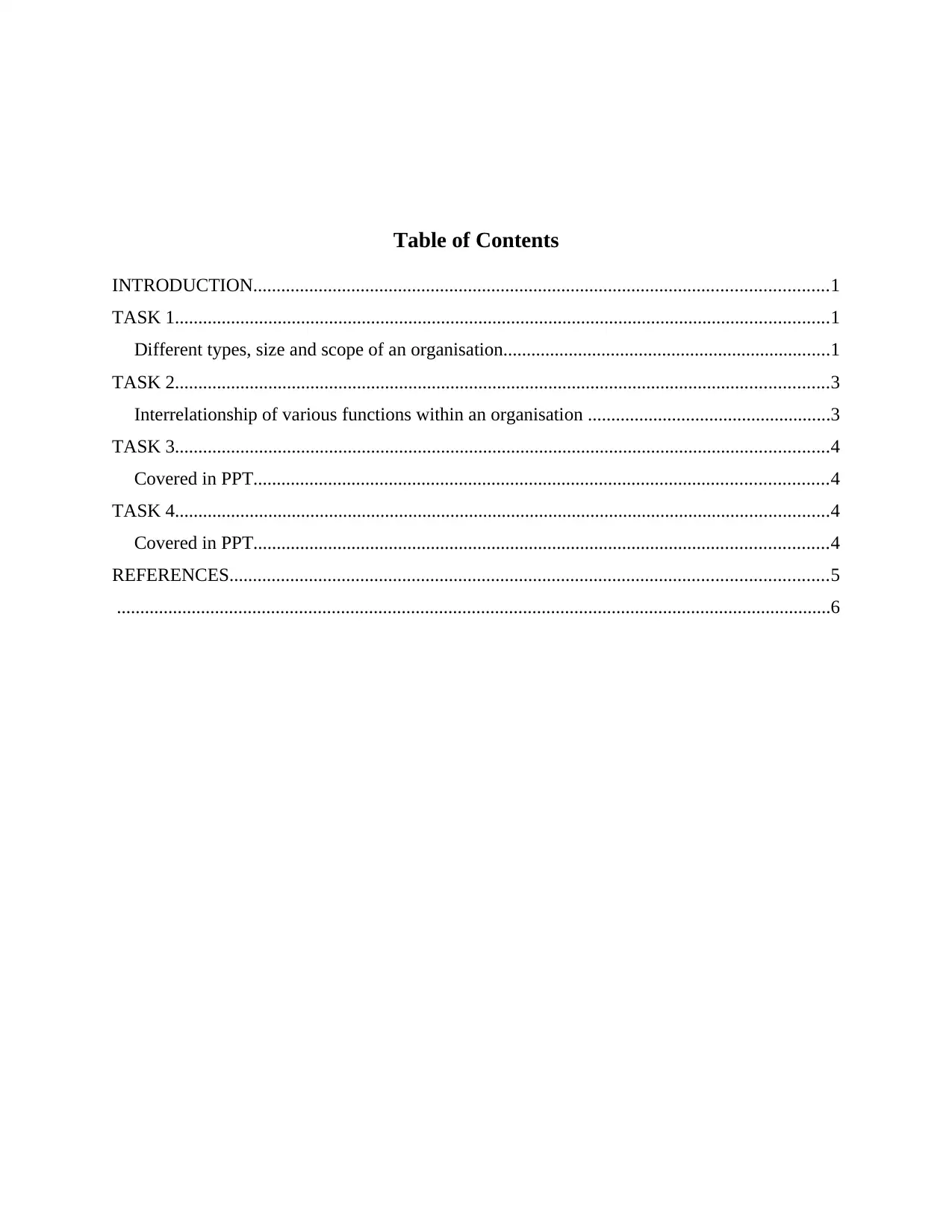
Table of Contents
INTRODUCTION...........................................................................................................................1
TASK 1............................................................................................................................................1
Different types, size and scope of an organisation......................................................................1
TASK 2............................................................................................................................................3
Interrelationship of various functions within an organisation ....................................................3
TASK 3............................................................................................................................................4
Covered in PPT...........................................................................................................................4
TASK 4............................................................................................................................................4
Covered in PPT...........................................................................................................................4
REFERENCES................................................................................................................................5
.........................................................................................................................................................6
INTRODUCTION...........................................................................................................................1
TASK 1............................................................................................................................................1
Different types, size and scope of an organisation......................................................................1
TASK 2............................................................................................................................................3
Interrelationship of various functions within an organisation ....................................................3
TASK 3............................................................................................................................................4
Covered in PPT...........................................................................................................................4
TASK 4............................................................................................................................................4
Covered in PPT...........................................................................................................................4
REFERENCES................................................................................................................................5
.........................................................................................................................................................6

⊘ This is a preview!⊘
Do you want full access?
Subscribe today to unlock all pages.

Trusted by 1+ million students worldwide
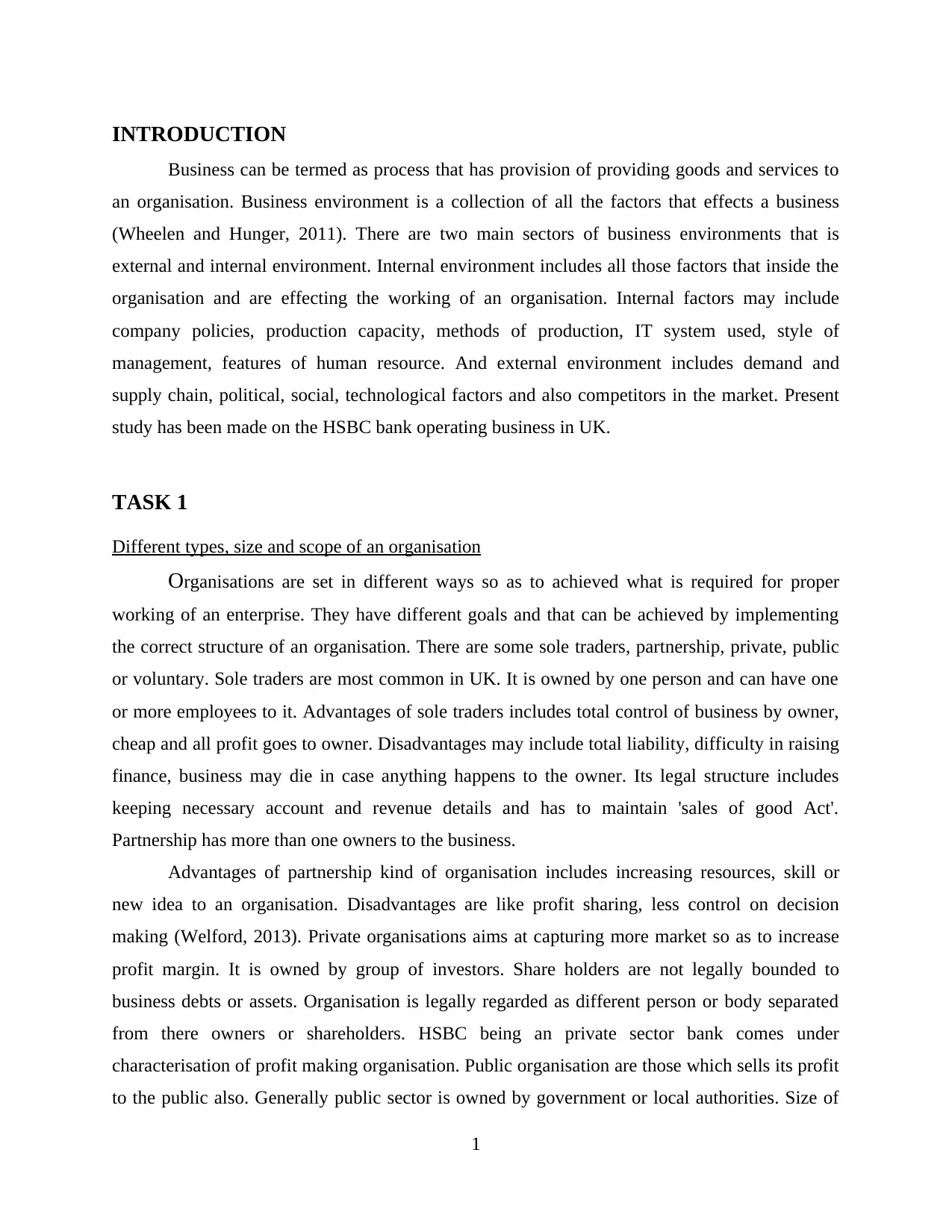
INTRODUCTION
Business can be termed as process that has provision of providing goods and services to
an organisation. Business environment is a collection of all the factors that effects a business
(Wheelen and Hunger, 2011). There are two main sectors of business environments that is
external and internal environment. Internal environment includes all those factors that inside the
organisation and are effecting the working of an organisation. Internal factors may include
company policies, production capacity, methods of production, IT system used, style of
management, features of human resource. And external environment includes demand and
supply chain, political, social, technological factors and also competitors in the market. Present
study has been made on the HSBC bank operating business in UK.
TASK 1
Different types, size and scope of an organisation
Organisations are set in different ways so as to achieved what is required for proper
working of an enterprise. They have different goals and that can be achieved by implementing
the correct structure of an organisation. There are some sole traders, partnership, private, public
or voluntary. Sole traders are most common in UK. It is owned by one person and can have one
or more employees to it. Advantages of sole traders includes total control of business by owner,
cheap and all profit goes to owner. Disadvantages may include total liability, difficulty in raising
finance, business may die in case anything happens to the owner. Its legal structure includes
keeping necessary account and revenue details and has to maintain 'sales of good Act'.
Partnership has more than one owners to the business.
Advantages of partnership kind of organisation includes increasing resources, skill or
new idea to an organisation. Disadvantages are like profit sharing, less control on decision
making (Welford, 2013). Private organisations aims at capturing more market so as to increase
profit margin. It is owned by group of investors. Share holders are not legally bounded to
business debts or assets. Organisation is legally regarded as different person or body separated
from there owners or shareholders. HSBC being an private sector bank comes under
characterisation of profit making organisation. Public organisation are those which sells its profit
to the public also. Generally public sector is owned by government or local authorities. Size of
1
Business can be termed as process that has provision of providing goods and services to
an organisation. Business environment is a collection of all the factors that effects a business
(Wheelen and Hunger, 2011). There are two main sectors of business environments that is
external and internal environment. Internal environment includes all those factors that inside the
organisation and are effecting the working of an organisation. Internal factors may include
company policies, production capacity, methods of production, IT system used, style of
management, features of human resource. And external environment includes demand and
supply chain, political, social, technological factors and also competitors in the market. Present
study has been made on the HSBC bank operating business in UK.
TASK 1
Different types, size and scope of an organisation
Organisations are set in different ways so as to achieved what is required for proper
working of an enterprise. They have different goals and that can be achieved by implementing
the correct structure of an organisation. There are some sole traders, partnership, private, public
or voluntary. Sole traders are most common in UK. It is owned by one person and can have one
or more employees to it. Advantages of sole traders includes total control of business by owner,
cheap and all profit goes to owner. Disadvantages may include total liability, difficulty in raising
finance, business may die in case anything happens to the owner. Its legal structure includes
keeping necessary account and revenue details and has to maintain 'sales of good Act'.
Partnership has more than one owners to the business.
Advantages of partnership kind of organisation includes increasing resources, skill or
new idea to an organisation. Disadvantages are like profit sharing, less control on decision
making (Welford, 2013). Private organisations aims at capturing more market so as to increase
profit margin. It is owned by group of investors. Share holders are not legally bounded to
business debts or assets. Organisation is legally regarded as different person or body separated
from there owners or shareholders. HSBC being an private sector bank comes under
characterisation of profit making organisation. Public organisation are those which sells its profit
to the public also. Generally public sector is owned by government or local authorities. Size of
1
Paraphrase This Document
Need a fresh take? Get an instant paraphrase of this document with our AI Paraphraser
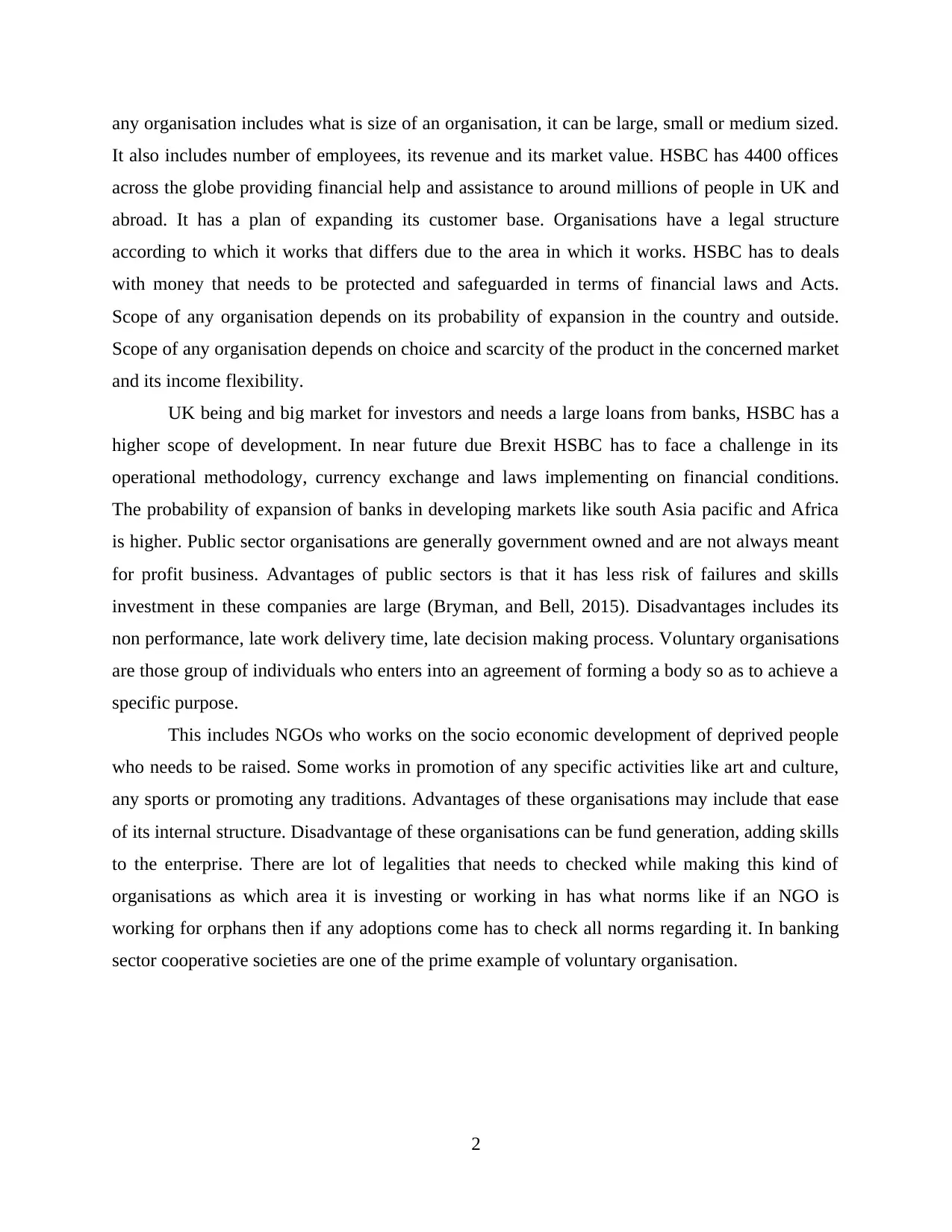
any organisation includes what is size of an organisation, it can be large, small or medium sized.
It also includes number of employees, its revenue and its market value. HSBC has 4400 offices
across the globe providing financial help and assistance to around millions of people in UK and
abroad. It has a plan of expanding its customer base. Organisations have a legal structure
according to which it works that differs due to the area in which it works. HSBC has to deals
with money that needs to be protected and safeguarded in terms of financial laws and Acts.
Scope of any organisation depends on its probability of expansion in the country and outside.
Scope of any organisation depends on choice and scarcity of the product in the concerned market
and its income flexibility.
UK being and big market for investors and needs a large loans from banks, HSBC has a
higher scope of development. In near future due Brexit HSBC has to face a challenge in its
operational methodology, currency exchange and laws implementing on financial conditions.
The probability of expansion of banks in developing markets like south Asia pacific and Africa
is higher. Public sector organisations are generally government owned and are not always meant
for profit business. Advantages of public sectors is that it has less risk of failures and skills
investment in these companies are large (Bryman, and Bell, 2015). Disadvantages includes its
non performance, late work delivery time, late decision making process. Voluntary organisations
are those group of individuals who enters into an agreement of forming a body so as to achieve a
specific purpose.
This includes NGOs who works on the socio economic development of deprived people
who needs to be raised. Some works in promotion of any specific activities like art and culture,
any sports or promoting any traditions. Advantages of these organisations may include that ease
of its internal structure. Disadvantage of these organisations can be fund generation, adding skills
to the enterprise. There are lot of legalities that needs to checked while making this kind of
organisations as which area it is investing or working in has what norms like if an NGO is
working for orphans then if any adoptions come has to check all norms regarding it. In banking
sector cooperative societies are one of the prime example of voluntary organisation.
2
It also includes number of employees, its revenue and its market value. HSBC has 4400 offices
across the globe providing financial help and assistance to around millions of people in UK and
abroad. It has a plan of expanding its customer base. Organisations have a legal structure
according to which it works that differs due to the area in which it works. HSBC has to deals
with money that needs to be protected and safeguarded in terms of financial laws and Acts.
Scope of any organisation depends on its probability of expansion in the country and outside.
Scope of any organisation depends on choice and scarcity of the product in the concerned market
and its income flexibility.
UK being and big market for investors and needs a large loans from banks, HSBC has a
higher scope of development. In near future due Brexit HSBC has to face a challenge in its
operational methodology, currency exchange and laws implementing on financial conditions.
The probability of expansion of banks in developing markets like south Asia pacific and Africa
is higher. Public sector organisations are generally government owned and are not always meant
for profit business. Advantages of public sectors is that it has less risk of failures and skills
investment in these companies are large (Bryman, and Bell, 2015). Disadvantages includes its
non performance, late work delivery time, late decision making process. Voluntary organisations
are those group of individuals who enters into an agreement of forming a body so as to achieve a
specific purpose.
This includes NGOs who works on the socio economic development of deprived people
who needs to be raised. Some works in promotion of any specific activities like art and culture,
any sports or promoting any traditions. Advantages of these organisations may include that ease
of its internal structure. Disadvantage of these organisations can be fund generation, adding skills
to the enterprise. There are lot of legalities that needs to checked while making this kind of
organisations as which area it is investing or working in has what norms like if an NGO is
working for orphans then if any adoptions come has to check all norms regarding it. In banking
sector cooperative societies are one of the prime example of voluntary organisation.
2
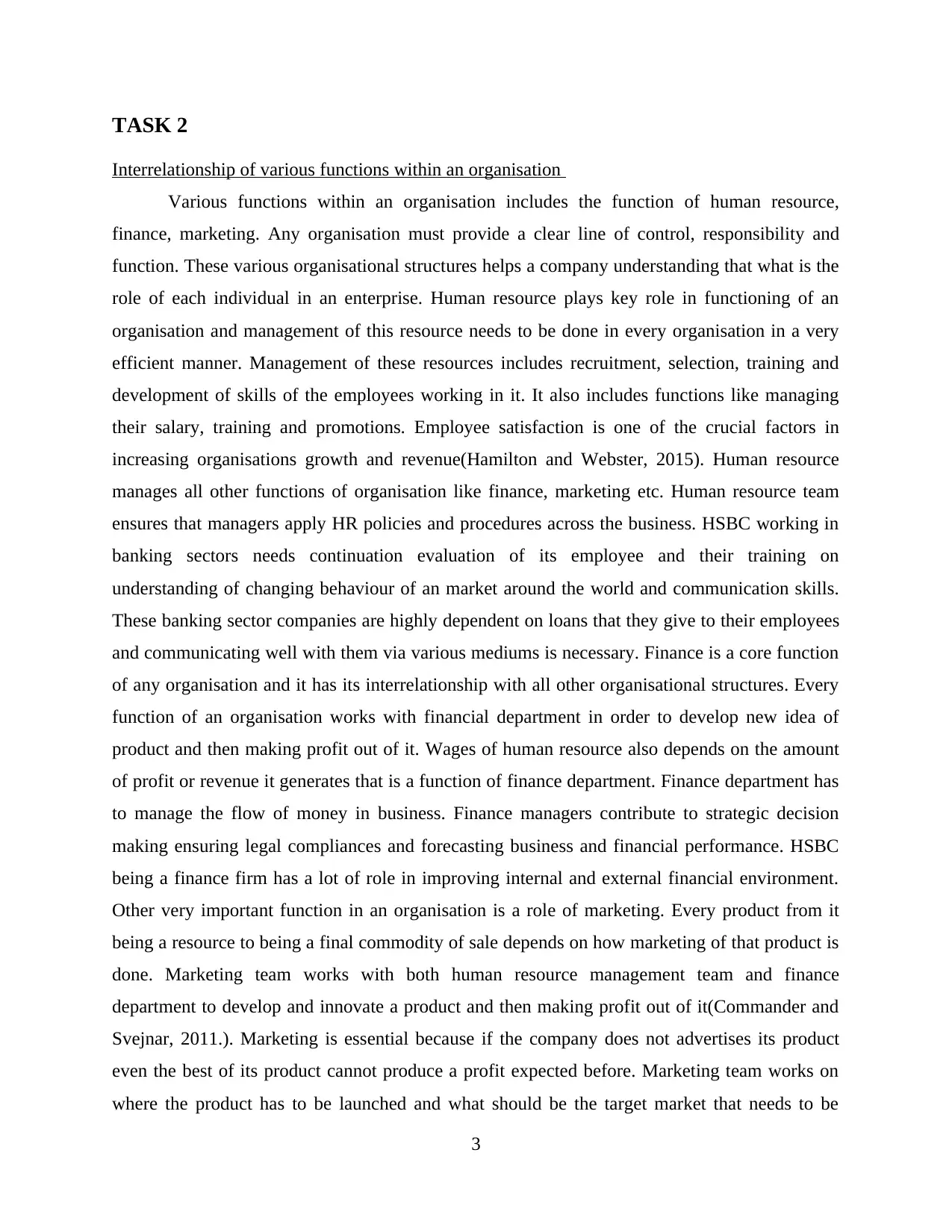
TASK 2
Interrelationship of various functions within an organisation
Various functions within an organisation includes the function of human resource,
finance, marketing. Any organisation must provide a clear line of control, responsibility and
function. These various organisational structures helps a company understanding that what is the
role of each individual in an enterprise. Human resource plays key role in functioning of an
organisation and management of this resource needs to be done in every organisation in a very
efficient manner. Management of these resources includes recruitment, selection, training and
development of skills of the employees working in it. It also includes functions like managing
their salary, training and promotions. Employee satisfaction is one of the crucial factors in
increasing organisations growth and revenue(Hamilton and Webster, 2015). Human resource
manages all other functions of organisation like finance, marketing etc. Human resource team
ensures that managers apply HR policies and procedures across the business. HSBC working in
banking sectors needs continuation evaluation of its employee and their training on
understanding of changing behaviour of an market around the world and communication skills.
These banking sector companies are highly dependent on loans that they give to their employees
and communicating well with them via various mediums is necessary. Finance is a core function
of any organisation and it has its interrelationship with all other organisational structures. Every
function of an organisation works with financial department in order to develop new idea of
product and then making profit out of it. Wages of human resource also depends on the amount
of profit or revenue it generates that is a function of finance department. Finance department has
to manage the flow of money in business. Finance managers contribute to strategic decision
making ensuring legal compliances and forecasting business and financial performance. HSBC
being a finance firm has a lot of role in improving internal and external financial environment.
Other very important function in an organisation is a role of marketing. Every product from it
being a resource to being a final commodity of sale depends on how marketing of that product is
done. Marketing team works with both human resource management team and finance
department to develop and innovate a product and then making profit out of it(Commander and
Svejnar, 2011.). Marketing is essential because if the company does not advertises its product
even the best of its product cannot produce a profit expected before. Marketing team works on
where the product has to be launched and what should be the target market that needs to be
3
Interrelationship of various functions within an organisation
Various functions within an organisation includes the function of human resource,
finance, marketing. Any organisation must provide a clear line of control, responsibility and
function. These various organisational structures helps a company understanding that what is the
role of each individual in an enterprise. Human resource plays key role in functioning of an
organisation and management of this resource needs to be done in every organisation in a very
efficient manner. Management of these resources includes recruitment, selection, training and
development of skills of the employees working in it. It also includes functions like managing
their salary, training and promotions. Employee satisfaction is one of the crucial factors in
increasing organisations growth and revenue(Hamilton and Webster, 2015). Human resource
manages all other functions of organisation like finance, marketing etc. Human resource team
ensures that managers apply HR policies and procedures across the business. HSBC working in
banking sectors needs continuation evaluation of its employee and their training on
understanding of changing behaviour of an market around the world and communication skills.
These banking sector companies are highly dependent on loans that they give to their employees
and communicating well with them via various mediums is necessary. Finance is a core function
of any organisation and it has its interrelationship with all other organisational structures. Every
function of an organisation works with financial department in order to develop new idea of
product and then making profit out of it. Wages of human resource also depends on the amount
of profit or revenue it generates that is a function of finance department. Finance department has
to manage the flow of money in business. Finance managers contribute to strategic decision
making ensuring legal compliances and forecasting business and financial performance. HSBC
being a finance firm has a lot of role in improving internal and external financial environment.
Other very important function in an organisation is a role of marketing. Every product from it
being a resource to being a final commodity of sale depends on how marketing of that product is
done. Marketing team works with both human resource management team and finance
department to develop and innovate a product and then making profit out of it(Commander and
Svejnar, 2011.). Marketing is essential because if the company does not advertises its product
even the best of its product cannot produce a profit expected before. Marketing team works on
where the product has to be launched and what should be the target market that needs to be
3
⊘ This is a preview!⊘
Do you want full access?
Subscribe today to unlock all pages.

Trusted by 1+ million students worldwide
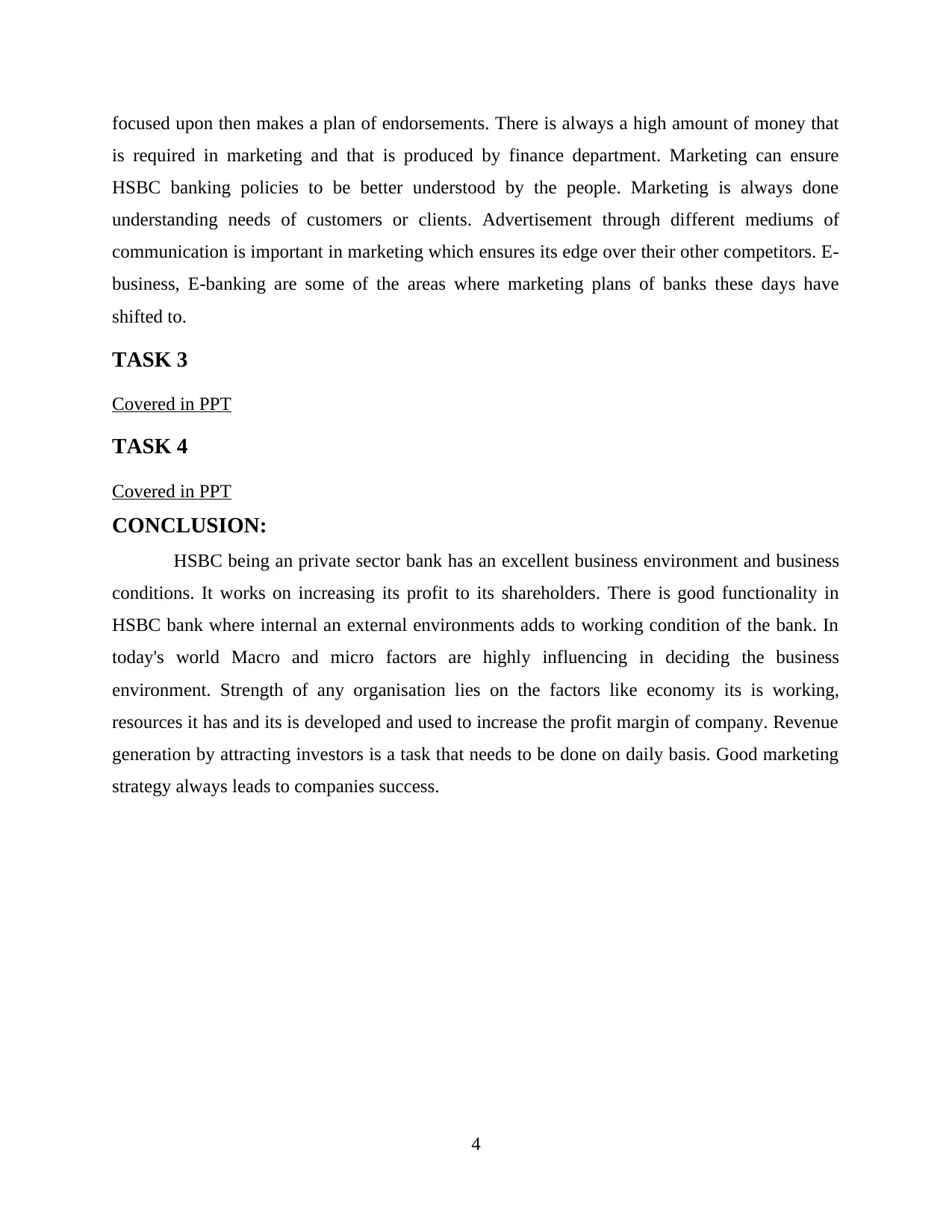
focused upon then makes a plan of endorsements. There is always a high amount of money that
is required in marketing and that is produced by finance department. Marketing can ensure
HSBC banking policies to be better understood by the people. Marketing is always done
understanding needs of customers or clients. Advertisement through different mediums of
communication is important in marketing which ensures its edge over their other competitors. E-
business, E-banking are some of the areas where marketing plans of banks these days have
shifted to.
TASK 3
Covered in PPT
TASK 4
Covered in PPT
CONCLUSION:
HSBC being an private sector bank has an excellent business environment and business
conditions. It works on increasing its profit to its shareholders. There is good functionality in
HSBC bank where internal an external environments adds to working condition of the bank. In
today's world Macro and micro factors are highly influencing in deciding the business
environment. Strength of any organisation lies on the factors like economy its is working,
resources it has and its is developed and used to increase the profit margin of company. Revenue
generation by attracting investors is a task that needs to be done on daily basis. Good marketing
strategy always leads to companies success.
4
is required in marketing and that is produced by finance department. Marketing can ensure
HSBC banking policies to be better understood by the people. Marketing is always done
understanding needs of customers or clients. Advertisement through different mediums of
communication is important in marketing which ensures its edge over their other competitors. E-
business, E-banking are some of the areas where marketing plans of banks these days have
shifted to.
TASK 3
Covered in PPT
TASK 4
Covered in PPT
CONCLUSION:
HSBC being an private sector bank has an excellent business environment and business
conditions. It works on increasing its profit to its shareholders. There is good functionality in
HSBC bank where internal an external environments adds to working condition of the bank. In
today's world Macro and micro factors are highly influencing in deciding the business
environment. Strength of any organisation lies on the factors like economy its is working,
resources it has and its is developed and used to increase the profit margin of company. Revenue
generation by attracting investors is a task that needs to be done on daily basis. Good marketing
strategy always leads to companies success.
4
Paraphrase This Document
Need a fresh take? Get an instant paraphrase of this document with our AI Paraphraser
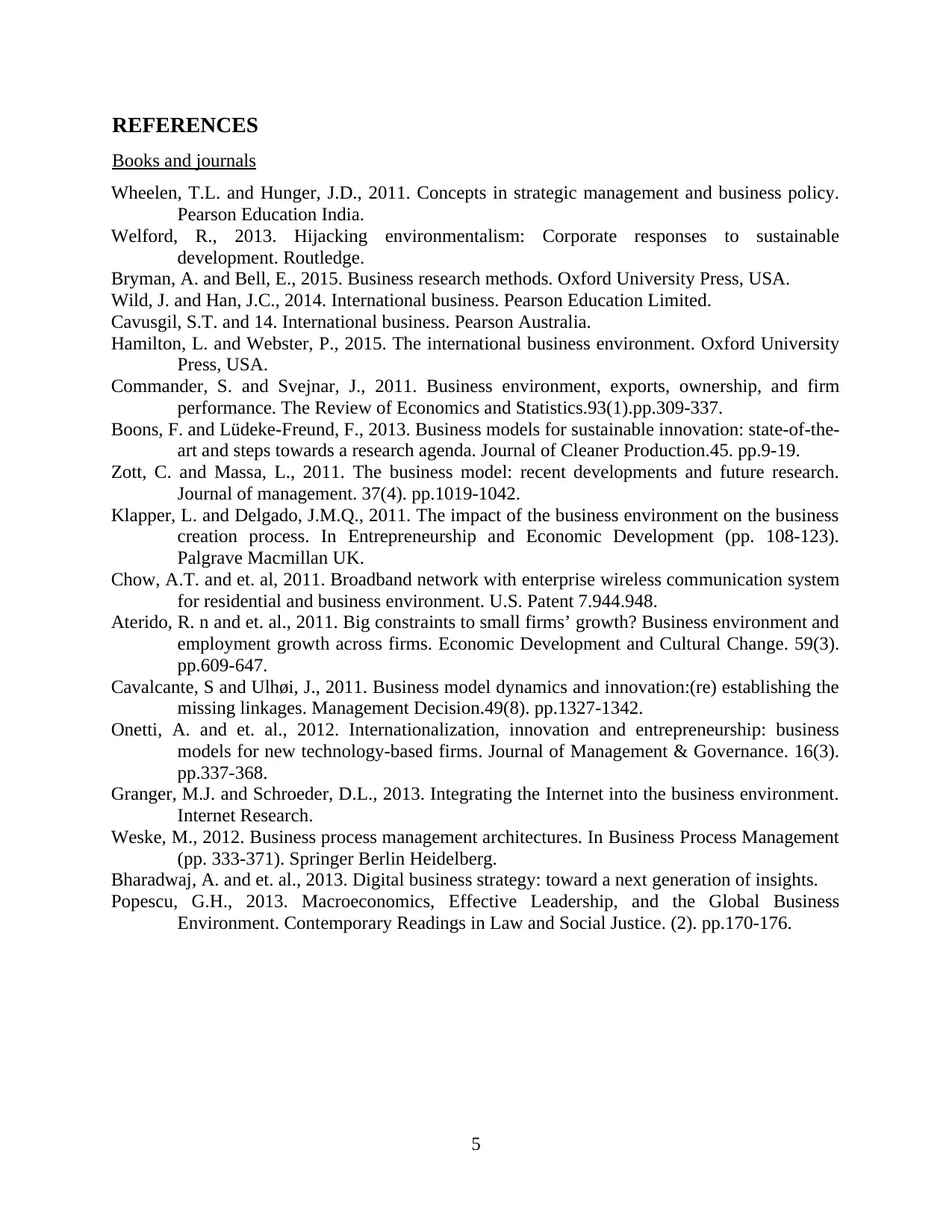
REFERENCES
Books and journals
Wheelen, T.L. and Hunger, J.D., 2011. Concepts in strategic management and business policy.
Pearson Education India.
Welford, R., 2013. Hijacking environmentalism: Corporate responses to sustainable
development. Routledge.
Bryman, A. and Bell, E., 2015. Business research methods. Oxford University Press, USA.
Wild, J. and Han, J.C., 2014. International business. Pearson Education Limited.
Cavusgil, S.T. and 14. International business. Pearson Australia.
Hamilton, L. and Webster, P., 2015. The international business environment. Oxford University
Press, USA.
Commander, S. and Svejnar, J., 2011. Business environment, exports, ownership, and firm
performance. The Review of Economics and Statistics.93(1).pp.309-337.
Boons, F. and Lüdeke-Freund, F., 2013. Business models for sustainable innovation: state-of-the-
art and steps towards a research agenda. Journal of Cleaner Production.45. pp.9-19.
Zott, C. and Massa, L., 2011. The business model: recent developments and future research.
Journal of management. 37(4). pp.1019-1042.
Klapper, L. and Delgado, J.M.Q., 2011. The impact of the business environment on the business
creation process. In Entrepreneurship and Economic Development (pp. 108-123).
Palgrave Macmillan UK.
Chow, A.T. and et. al, 2011. Broadband network with enterprise wireless communication system
for residential and business environment. U.S. Patent 7.944.948.
Aterido, R. n and et. al., 2011. Big constraints to small firms’ growth? Business environment and
employment growth across firms. Economic Development and Cultural Change. 59(3).
pp.609-647.
Cavalcante, S and Ulhøi, J., 2011. Business model dynamics and innovation:(re) establishing the
missing linkages. Management Decision.49(8). pp.1327-1342.
Onetti, A. and et. al., 2012. Internationalization, innovation and entrepreneurship: business
models for new technology-based firms. Journal of Management & Governance. 16(3).
pp.337-368.
Granger, M.J. and Schroeder, D.L., 2013. Integrating the Internet into the business environment.
Internet Research.
Weske, M., 2012. Business process management architectures. In Business Process Management
(pp. 333-371). Springer Berlin Heidelberg.
Bharadwaj, A. and et. al., 2013. Digital business strategy: toward a next generation of insights.
Popescu, G.H., 2013. Macroeconomics, Effective Leadership, and the Global Business
Environment. Contemporary Readings in Law and Social Justice. (2). pp.170-176.
5
Books and journals
Wheelen, T.L. and Hunger, J.D., 2011. Concepts in strategic management and business policy.
Pearson Education India.
Welford, R., 2013. Hijacking environmentalism: Corporate responses to sustainable
development. Routledge.
Bryman, A. and Bell, E., 2015. Business research methods. Oxford University Press, USA.
Wild, J. and Han, J.C., 2014. International business. Pearson Education Limited.
Cavusgil, S.T. and 14. International business. Pearson Australia.
Hamilton, L. and Webster, P., 2015. The international business environment. Oxford University
Press, USA.
Commander, S. and Svejnar, J., 2011. Business environment, exports, ownership, and firm
performance. The Review of Economics and Statistics.93(1).pp.309-337.
Boons, F. and Lüdeke-Freund, F., 2013. Business models for sustainable innovation: state-of-the-
art and steps towards a research agenda. Journal of Cleaner Production.45. pp.9-19.
Zott, C. and Massa, L., 2011. The business model: recent developments and future research.
Journal of management. 37(4). pp.1019-1042.
Klapper, L. and Delgado, J.M.Q., 2011. The impact of the business environment on the business
creation process. In Entrepreneurship and Economic Development (pp. 108-123).
Palgrave Macmillan UK.
Chow, A.T. and et. al, 2011. Broadband network with enterprise wireless communication system
for residential and business environment. U.S. Patent 7.944.948.
Aterido, R. n and et. al., 2011. Big constraints to small firms’ growth? Business environment and
employment growth across firms. Economic Development and Cultural Change. 59(3).
pp.609-647.
Cavalcante, S and Ulhøi, J., 2011. Business model dynamics and innovation:(re) establishing the
missing linkages. Management Decision.49(8). pp.1327-1342.
Onetti, A. and et. al., 2012. Internationalization, innovation and entrepreneurship: business
models for new technology-based firms. Journal of Management & Governance. 16(3).
pp.337-368.
Granger, M.J. and Schroeder, D.L., 2013. Integrating the Internet into the business environment.
Internet Research.
Weske, M., 2012. Business process management architectures. In Business Process Management
(pp. 333-371). Springer Berlin Heidelberg.
Bharadwaj, A. and et. al., 2013. Digital business strategy: toward a next generation of insights.
Popescu, G.H., 2013. Macroeconomics, Effective Leadership, and the Global Business
Environment. Contemporary Readings in Law and Social Justice. (2). pp.170-176.
5
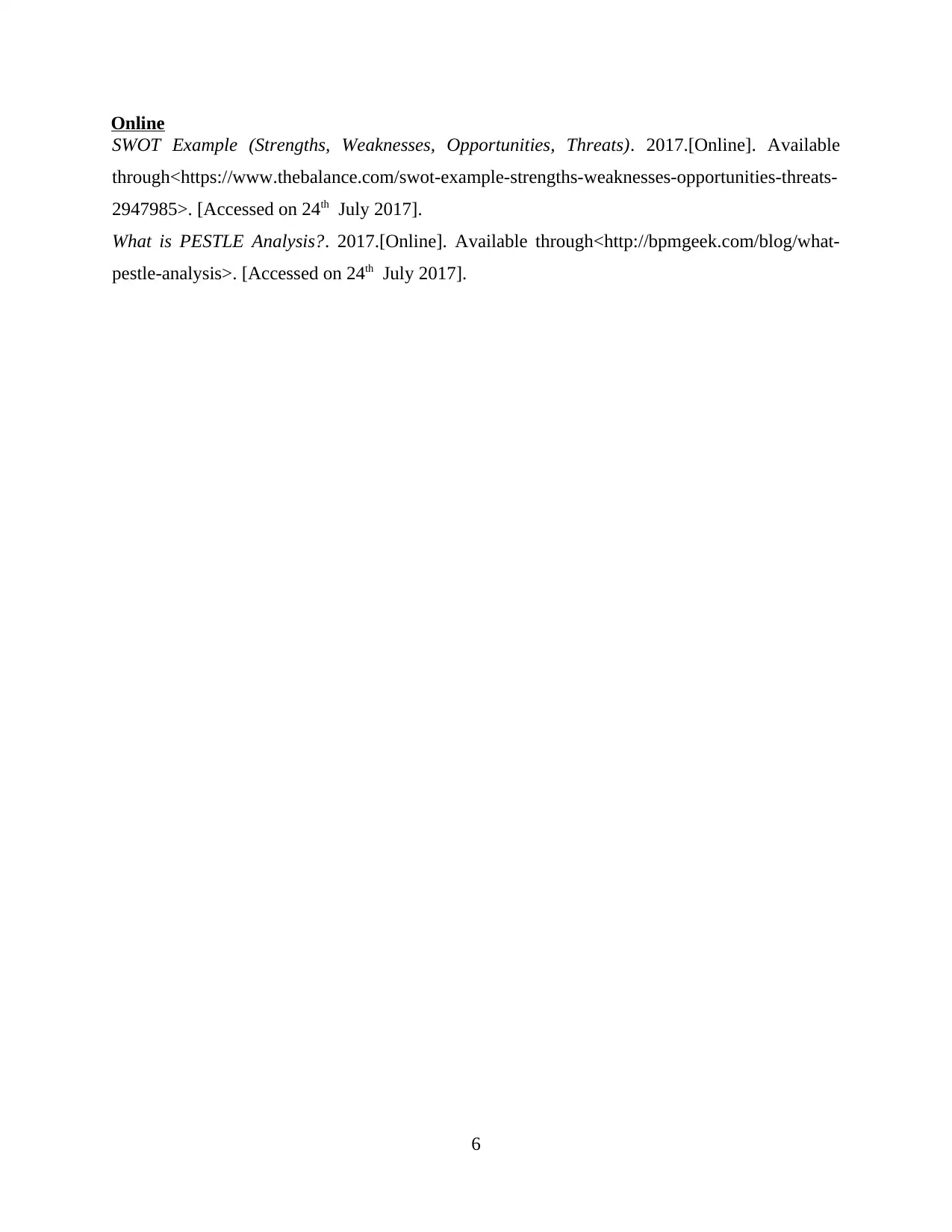
Online
SWOT Example (Strengths, Weaknesses, Opportunities, Threats). 2017.[Online]. Available
through<https://www.thebalance.com/swot-example-strengths-weaknesses-opportunities-threats-
2947985>. [Accessed on 24th July 2017].
What is PESTLE Analysis?. 2017.[Online]. Available through<http://bpmgeek.com/blog/what-
pestle-analysis>. [Accessed on 24th July 2017].
6
SWOT Example (Strengths, Weaknesses, Opportunities, Threats). 2017.[Online]. Available
through<https://www.thebalance.com/swot-example-strengths-weaknesses-opportunities-threats-
2947985>. [Accessed on 24th July 2017].
What is PESTLE Analysis?. 2017.[Online]. Available through<http://bpmgeek.com/blog/what-
pestle-analysis>. [Accessed on 24th July 2017].
6
⊘ This is a preview!⊘
Do you want full access?
Subscribe today to unlock all pages.

Trusted by 1+ million students worldwide
1 out of 9
Related Documents
Your All-in-One AI-Powered Toolkit for Academic Success.
+13062052269
info@desklib.com
Available 24*7 on WhatsApp / Email
![[object Object]](/_next/static/media/star-bottom.7253800d.svg)
Unlock your academic potential
Copyright © 2020–2025 A2Z Services. All Rights Reserved. Developed and managed by ZUCOL.





